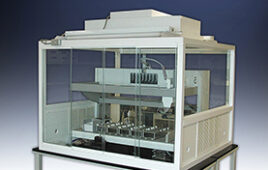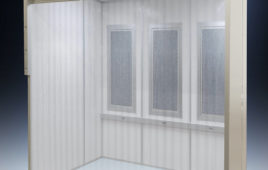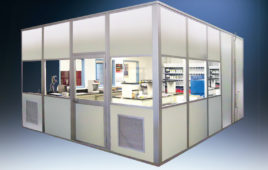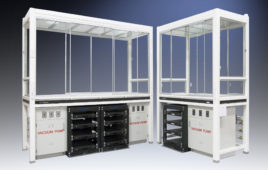The pharmaceutical industry requires some of the most strictly monitored environments in any manufacturing sector, with cleanrooms the most monitored areas of all. Although cleanrooms vary in size and complexity, the prevention of access-related contaminant infiltration is crucial to almost all of them, and high-speed doors play an integral role in it.
Recent advancements in doors used in cleanroom applications have kept pace with standards set by the U.S. Food and Drug Administration (FDA), as well as Current Good Manufacturing Practices (cGMP). Before examining them, however, let’s review standard cleanroom requirements.
The Cleanroom
Cleanrooms maintain a set concentration level of airborne particles and control a variety of environmental factors, including airflow patterns, temperature, humidity and pressurization. Though the types of potential challenges may vary—from electrostatic discharge, dust, microbes, aerosol particles, or chemical vapors to other airborne contaminants—keeping clean is the name of the game in all applications.
Cleanrooms typically use high-efficiency particulate air (HEPA) filters to remove particles larger than 0.5 μm (0.02 mils). Nearly all cleanrooms maintain an air pressure differential between by forcing air from the opening’s cleaner side to the less-clean side. As such, most facilities incorporate multiple pressure steps within the building’s structure, ranging from 5 to 13 Pa (0.02 to 0.05 w.g.) between rooms and as high as 50 Pa (0.2 w.g.).
Every cleanroom has a controlled level of contamination determined by the number of particles per cubic meter at a specified particle size, with pharma industry cleanroom generally in the range of ISO 5, ISO 6, ISO 7 or ISO 8.
To give perspective, the outside air in a typical city contains 35 million particles per cubic meter in the range of 0.5 μm (0.02 mils) and larger in diameter, corresponding to an ISO 9 cleanroom. On the opposite end of the spectrum, an ISO 1 cleanroom allows no particles in that size range and only 12 particles per cubic meter of 0.3 μm (0.01 mils) and smaller.
The Role of High-speed Doors
High-speed doors play a key role in maintaining clean operations in pharmaceutical plants. They are designed to address facility needs for environmental control, productivity and safety (as well as cleanliness). In cleanroom applications, they are used to maintain correct room pressures, air circulation rates and optimal operating efficiency and to prevent cross-contamination. High operating speeds are critical to minimize air infiltration when staff members enter or exit.
Cleanroom doors should be cGMP and FDA compliant, highly durable and easy to clean. Specifically, they must be able to stand up to repeated cleaning with chemical solvents and have a smooth, hard, non-porous surface resistant to microbial and fungal growth. In order to do this, door materials should be corrosion-resistant and use side frames and shrouds constructed from stainless steel.
The design should also include a tapered surface and edges that effectively eliminate harborage of dust and other contaminants. The incorporation of a lubrication-free design is another important feature in cleanroom doors, as lubricants can actually attract particulates.
Doors with exposed fasteners and coils should be avoided when possible, as they take longer to clean and could harbor contaminants. When possible, any control boxes should be mounted flush with the wall or outside of the cleanroom.

Cleanroom high speed roll-up doors have a tough PVC vinyl curtain, and are resistant to collecting dust along with being easier to clean. Image: Rite-Hite
Air Locks
The ability of cleanroom doors to accommodate site-specific needs is another consideration. These needs could include features such as vision panels, push plates or other activation devices, as well as magnetic locks and—perhaps most importantly—interlocking systems (air locks). Air locks are found in entrances and exits, gowning and de-gowning areas, and material transfer locations. In all these areas, it is important to keep two doors from being open simultaneously to prevent air infiltration from one space to the other. The best door systems allow for wireless interlocking of air locks.
A door capable of at least 50 Pa in pressure differential is needed to maintain a tight seal and minimize air leakage. A properly designed door helps ensure the facility’s makeup fans can satisfy the required amount of makeup air needed to maintain pressure.
Another prerequisite in overall door design is cleanliness, since doors must operate in a pristine production environment.
Bi-parting Doors
Traditionally, pharmaceutical facilities use bi-parting doors made from stainless steel or fiberglass. However, new-age doors made from a heavy-duty 40-oz. PVC curtain can provide the same types of benefits as those standard doors. The material is smooth enough to minimize harborage of dust and particulates, making it compliant with FDA and cGMP guidelines.
Side frames for these material curtain doors are made from stainless steel for compliance with industry standards. The most advanced doors in this category include a spring tube design that minimize the footprint on either side of the door. Some even feature an obstruction-sensing reverse system that protects employees and equipment going through the door opening.
Additionally, lightweight fabric allow doors to open and close faster for maximum environmental control. Coupled with a variable frequency drive motor in advanced models, bi-parting doors can operate at speeds of up to 120 inches per second when opening and 40 inches per second when closing.
Upward-acting Doors
Bi-parting doors aren’t the only option in the pharmaceutical industry. Many facilities are finding benefits—like a decreased footprint—with upward-acting “roll-up” doors. A rigid-panel center-opening door spanning a 6-foot-wide opening requires approximately 3 feet of wall space on each side when its panels open, while a roll-up door doesn’t require any, since its fabric “curtain” collects in a head assembly at the top of the door when opened.
The newest generation of roll-up doors features anti-microbial materials and other cleanroom upgrades. These new features, coupled with their tight sealing and high cycle speeds, are reasons they are catching on with pharmaceutical facility managers. State-of-the-art high-speed door models can move at up to 100-inches per second, minimizing air intrusion while increasing productivity.
To ensure product integrity, pharmaceutical facilities require the most sanitary operations and equipment possible. The newest high-speed, bi-parting and roll-up doors are helping change the way the industry defines “best practices” when it comes to cleanroom areas.
Author’s note: The information herein is provided as a general reference regarding the use of the applicable product(s) in specific applications. This information is provided without warranty. It is your responsibility to ensure that you are using all mentioned products properly in your specific application and in accordance with all laws and regulations.
Jon Schumacher is the director of marketing for Rite-Hite Doors. He has been with the company for 24 years and is a vice-chair of the Door and Access Systems Manufacturers Association (DASMA).




